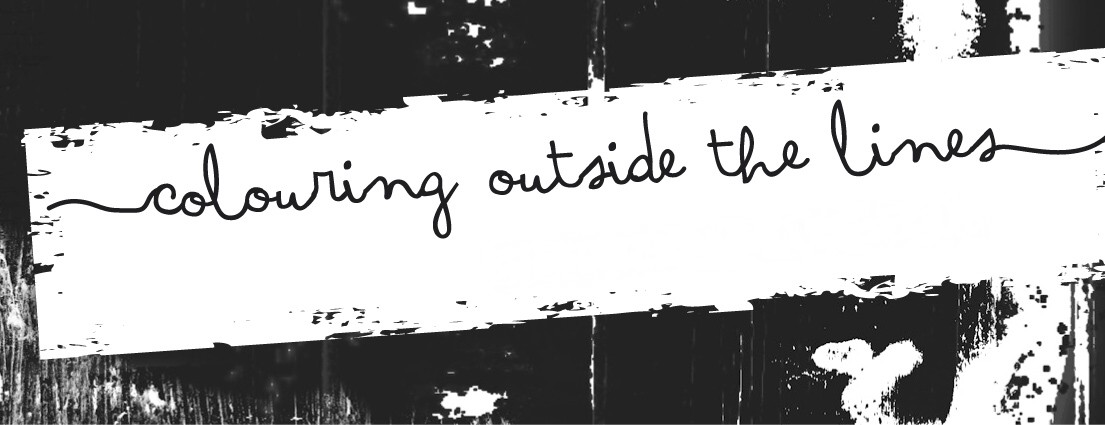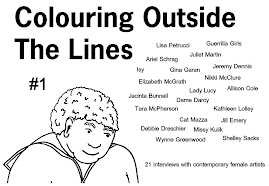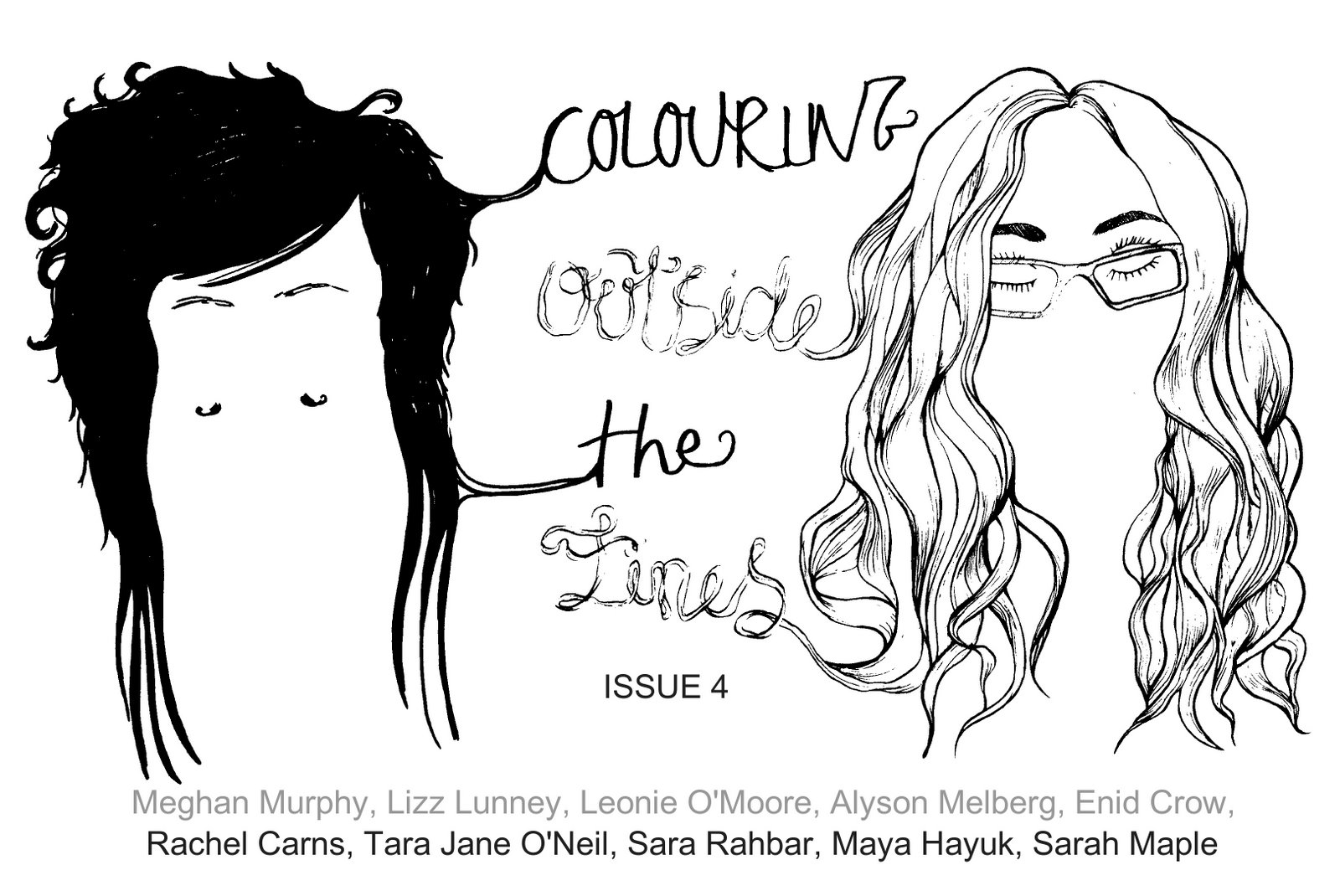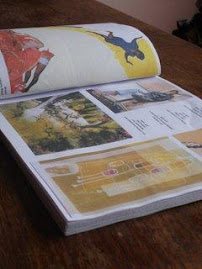


Nicole Steen
* Location: Vancouver, BC Canada
* How would you describe your art?: Glam feminist popart
* Currently working on: Painting a bowling pin for the Bowl-a Rama Pin Art Show at Asbury Lanes
* Day job: A chocolate novelty technician
* 3 Likes: My kitten... cheesy jokes.... and cheesy popcorn.
* 3 Dislikes: Gobbing... grouchy bus drivers... heading toward global destruction
* Daily Inspirations: The mountains outside my window.
* People & artists you admire: Isabel Samaras, Lisa Petrucci, Niagara, Neko Case, Candymaker George Tedlock (still going at 100!) Michael Moore, David Suzuki, anyone trying to make a difference.
* People & artists you admire: Isabel Samaras, Lisa Petrucci, Niagara, Neko Case, Candymaker George Tedlock (still going at 100!) Michael Moore, David Suzuki, anyone trying to make a difference.
* Favourite album(s) to listen to when working: Currently: Fox Confessor Brings the Flood - Neko Case, Mutations - Beck, Diaries of a Broken Heart - Castle Project
http://www.tartgallery.com/
http://www.tartgallery.com/
- - -
This interview with Nicole took place in April 2006. All images reproduced with permission © Nicole and the PopTarts
- - -
Hi Nicole, How are you?
I’m good! and busy.... Working on securing the use of images of artwork for a new lowbrow and pop underground art documentary project I’ve been working on with my partner Marcus Rogers," The Lowdown on Lowbrow". It includes artists Robt. Williams, The Pizz, Anthony Ausgang, SHAG, Isabel Samaras, Lisa Petrucci, I, Braineater,12 Midnite, Dirty Donny, The PopTarts and others.
Your work is packed with fantastic uses of glamour icons, comic book heroines, b-movie dames, movie queens, pin up girls, villainesses, fetish femmes and female musicians. What inspires your use of particular muses or subjects - How you decide who to depict?
I generally choose real women or female icons that have inspired me from a very young age. Everyone from old film noir actresses that I would watch on TV late at night to characters out of comic books to female musicians that have blazed a trail such as Wanda Jackson or Nina Hagen. I’ve tended to gravitate towards using women that already have a strong image and identity and have become somewhat legendary. The idea of "glamour" which is all about allure and enticement, some kind of spell...it’s such a fabrication but so ingrained in our society now that it is almost synonymous with being female or feminine.
Your paintings have been created on (or of) various “alternative” canvasses such as on bowling pins, rubber gloves, and guitars; thus taking the very idea of the importance of popular culture in art to the next level, by using it as art, and incorporating the everyday, the popular, into art and thus the everyday becomes art.
Using the rubber gloves came from an idea for a show about visual puns, and I came up with "Dirty Dishes" pinup style dancers on rubber gloves...and it took off from there. Painting on the gloves is very funny to me, on so many levels there are "sexual' connotations... but its also something subversive ... like women’s domestic work gloves are no longer used for the original purpose, they are now fetish items or relics. I’ve done many, many pairs now and do different themed ones and even do commissions.I play guitar and love old vintage electric guitars, I couldn't actually afford to own some of these collectibles so instead I just paint pictures of the guitars and I adorn them with female icons that suit the aesthetic of the particular brand be it Gretsch hollow body or a Telecaster.
How important is “the everyday’ in your work?
How important is “the everyday’ in your work?
My work is about how fantasy and idealism in the media affect us (also humour is a big part of it) so I would say that “the everyday" is important because we are surrounded and inundated with entertainment images all of the time.
Is it intentional that by painting portraits of women within a pop culture context you are also able to make an important comment about the location of women within popular culture?
Yes! Sometimes the images in the work are straight forward and may not seem out of context but the fact that the image has BECOME the icon and is being kind of regurgitated again from photographs or stills back onto canvas IS the comment. There may be a subtle difference or shading and I think being a female artist that has created the piece also places the imagery in a different context. It is a re-appropriation.
In my initial contact with you, you told me how you ‘love finding out about new female artists’. This is true for me too, this zine is both a way for me to celebrate female artistry and creativity as well as, on a more personal level, allowing me to discover and connect with female artists such as yourself.
One thing I find inspiring about your commitment to the promotion, observance and discovery of female artists is your idea of creating a Tart of the Month section to the PopTarts website. How important is this celebration and encouragement of female artistry to you?
When Vicki M. asked me to be in an all female group show she was curating I jumped at the chance to hook up with other female artists. From that we formed The PopTarts and continued to paint, have shows and eventually opened a gallery, the Tart Gallery where we could also feature more women artists. We would not be exclusive but would always try to make it balanced with as many male as female artists in the shows. The same goes for the Tart of the Month and our links page. I am always in search of women doing art in a similar vein.
The initial aims of the PopTarts was to show strictly female subjects, (as seen in your early exhibition, The Painted Ladies), an ideal that has continued throughout your career. Why was (and is) this important to you?
It has been a mission of sorts of The PopTarts to stick to artwork that represents the media portrayals of women in our culture. We don’t want to clobber anyone over the head with our message but our tongues are firmly planted in our cheeks. Our agenda is to create awareness and to inspire, and both Vicki and I would like to see every young girl pick up a paint brush. PopTarts have been the curators of exhibitions such as PINK, and Vicious Delicious and Ambitious, featuring the art work of teems of amazing female creators and artists.
Something that has unconsciously come to be a big theme in this issue of this zine is just how many of the artists I have interviewed are dedicated to, and deeply embroiled in working with and alongside other women in collaborative and collective group action and experience.
What do you think (female) collaboration has to offer your work, and ‘art’ in general?
Is collaborative, collective action important to you, politically?
Before working with other female artists in our collective The PopTarts, I hadn't considered what my motivating factor was, and why I was painting popular female subjects exactly. Talking and brainstorming with other women painters on shows and themes allowed me to focus on what it was I was really trying to get across with my art and also kind of flamed the passion I felt about underground DIY art movement. It spurred me on!
I have found the other female artists I encountered were also just as passionate and excited and willing to share and encourage....in turn I hope I’ve been able to help and inspire other women and I feel it is just exponential.
Your Dirty Dishes exhibition, where rubber washing up gloves were made-over, subverted and used as a canvas to depict images of pin-up/glamour girls provoked very interesting discussion about femininity, domesticity, and ultimately feminism, for me. In your experience, and with reference to exhibitions such as this particular one, to what extent do you personally see art as a useful medium to discuss or infer political issues that are important to you?
I believe that everything is political, although at times the political message in art can be ambiguous. To me art is obviously a statement but the "piece' can also be a question. I feel every piece of art I put out there is a question to the viewer. I think it is very complex and if you could explain it entirely in words it wouldn’t need to be "visual” art.
How important is subversion, and humour in your work? Is it fair of me to group the two ideas of humour and subversion together when referring to your work?
The idea behind The PopTarts was humourous subversion or subversive humour so it is entirely appropriate for you to group the ideas together. I personally love art that makes me laugh. It is very important to me to temper the injustice or anger I feel about society's exploitation and stereotyping of women with some humour in my art. I also think that you'll end up enticing the viewer with a wink and a nudge more than just pure shock value.
One of the most interesting things I read about your work (from a political point of view) is how strongly you feel about the appropriation of the image of the pin-up from a female point of view. You have claimed that your work is part of a ‘sometimes misunderstood genre due to the [historical] association of the imagery from a male perspective. Some feel these sexually charged works objectify women, others find it empowering; the appropriation of pin-ups as icons-of-strong-sexuality by women reclaiming the imagery.’
How important to you is creating images that act as an alternative to the historical female-as-object image?
Why is it important to you to celebrate strong female sexuality (as well as sexuality and femininity) in your work?
I don’t believe in censorship, so I think everyone should be free to express their sexuality as long as they are not infringing too much on others. To me it's the commercial exploitation that is so bizarre, the selling of sex (mostly represented by the female) in conjunction with every product under the sun.
I did a takeoff on Kraft "Whip" Sauces and had images of Bettie Page on the packages "CoolWhip", “DreamWhip" and "MiracleWhip" it was a play on words but also commentary on how women are used in advertising and to show how ludicrous it can be. To equate the desirous female with objects (ie cars, chewing gum, beer, soda pop etc) that companies want you to buy in some kind of brainwashing campaign where we are inundated with these images is what I see as harmful. It turns sexuality into something else that is quite soulless.
By female artists working with feminine imagery, and thus delineating their own artistic genre, (and, as a result, also subverting the male-gaze), to what degree do you think such art allows women to personally define their own creativity?
By female artists working with feminine imagery, and thus delineating their own artistic genre, (and, as a result, also subverting the male-gaze), to what degree do you think such art allows women to personally define their own creativity?
So far I see the work that lowbrow/underground female pin-up artists are doing is a subjecting of the retro pinup or glamour icon with a twist. As the underground art movement progresses a new form may takeover where women go beyond that irony and create a new model. Up and coming artists with different pop references may come from a post -post feminist standpoint. With me it seems to be a split between holding the pinups up on a pedestal (goddess worship) and also turning them on their side and lightly ridiculing, kind of lampooning their quaintness.
The underground nature of lowbrow art is increasingly being taken over-ground by recent changes in popular culture. Lisa Petrucci commented in the first issue of this zine that ‘a lot has changed in the past ten years due to a younger generation becoming aware of and embracing nostalgic popular culture like the neo-burlesque and rockabilly scenes’
I guess this opinion is further supported by things such as the recent Bettie Page Hollywood movie, and the increasing prominence of burlesque in the entertainment industry.
How does this shift in visibility affect art such as yours, (which originated from DIY ideals and understandings, and an appreciation of counter-cultural, underground aesthetics)?
I still feel there is a certain irony about burlesque and its resurgence. The women wanted to pay tribute to and revive an art that had been lost and now it seems that it might be in danger of going down the road that original burlesque did with stripping....debasing and cheapening it. As the fad catches on it will burn itself out eventually...and the original burlesque will still be remembered. I think Bettie Page is a counter culture icon for that very reason. She radiated a purity, a true essence, fearlessness and honesty that didn’t seem jaded and tarnished.
Artist, Jean Smith once wrote that ‘I think that [there is] a view that actually prevents people from trying something themselves. They believe there has to be so much skill and god-given talent. The idea that somebody can just stand up and do something through the experiences they’ve had or the way they think, that’s too much for some people.’
Reading your biog on your website, it appears your artistic background and involvement began with designing t-shirts and posters for punk bands, exhibiting in vintage clothes stores, playing in bands and being influenced by late night movies. In relation to Jean’s statement, how much do you feel your current artistic success has to do with creating as a result of the experiences you’ve had (are having) - Did (do) your life experiences encourage you to ‘try something yourself’?
When I was younger I looked up to musicians and artists that were living that life and I was inspired to do likewise. That DIY scene really fostered generations and pushed a 'YOU CAN DO IT" attitude. I was impressed with the passion and creativity around me and just wanted to continue and spread it around.I also felt it was important to stay in my city and support the underground in Vancouver no matter what. A lot of creative people leave and seek success elsewhere but I didn’t' want to abandon the town. I'm still here.
You are the director of the Indie Music Video Festival, how did you get involved with this?
My band at the time had 6 music videos that we had made ourselves. I knew it wasn’t easy to get indie music videos played and thought there needed to be a festival to celebrate and exhibit the non-commercial artistic clips that weren’t getting shown on MuchMusic and MTV. I asked all the local bands I knew plus some out of town ones and we screened the 1st IMVF at the Blinding Light micro-cinema in Vancouver in 2002. Now we are heading into our 5th season getting international submissions and screening the festival in cities across North America.
My band at the time had 6 music videos that we had made ourselves. I knew it wasn’t easy to get indie music videos played and thought there needed to be a festival to celebrate and exhibit the non-commercial artistic clips that weren’t getting shown on MuchMusic and MTV. I asked all the local bands I knew plus some out of town ones and we screened the 1st IMVF at the Blinding Light micro-cinema in Vancouver in 2002. Now we are heading into our 5th season getting international submissions and screening the festival in cities across North America.
Is it personally inspiring for you to see and view so much independent, DIY artwork, video, and music being created all around, and get to be involved in a festival to showcase and exhibit, support and promote it?; because to me it’s something that blows my mind - to see the wealth of creativity being put out by individuals driven solely by a fire in their belly. To be able to work first-hand with these people seems like something that would be endlessly inspiring to an individuals’ personal creativity.
Absolutely, it gets me very fired up and is the only reason I continue with it. I can't get over the great submissions we receive every year, how many amazingly wonderful music videos we get to see and show in the fest. It is a labour of love...and certainly isn’t about the bottom line. I donate my time. Hopefully the IMVF will cause a chain reaction and a whole bunch of music video fests will pop up worldwide.
Finally, one quick, geeky question that’s not really completely relevant to this interview, but one that I’ve gotta ask regardless, because it’s very exciting to me - how on earth did you get to be in the film, Ladies and Gentlemen the Fabulous Stains, and when did your band tour with Frightwig? What are your memories of these things - of being a part of what has now gone down as important riot-grrrl and 3rd wave feminist history?
Ladies and Gentlemen, The Fabulous Stains was shot in Vancouver. I was 15 and heard about the film needing punky extras, they actually didn’t want real punks but I qualified anyway and signed up to be a Skunk. Got outfitted and got my hair dyed and bleached. I took some time off school but missed a couple of shooting days because of exams...so I ended up being virtually left out of the movie...on the cutting-room floor. I recently saw the film again at a local screening and did catch glimpses of myself though. It was a great experience, on set with the Sex Pistols (even though it was just Paul Cook (nice!), and Steve Jones (wanker!)) and Paul Simenon from the Clash. I also got to meet Caroline Coon, who worked on the film as a consultant. She made a big impact on me....very talented woman.
My first band “Kill Pussycat Kill" opened for Frightwig (but we didn't tour with them... I wish!), turns out that Rebecca (Tucker) Sevrin was in Frightwig at the time and I later ended up being in an art book "Vicious ,Delicious and Ambitious: 20th Century Women Artists" by Sherri Cullison on Schiffer Books along with Rebecca and we met at an art show for the book in Los Angeles. Small world.















No comments:
Post a Comment